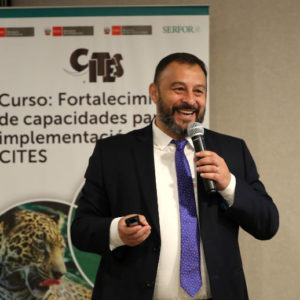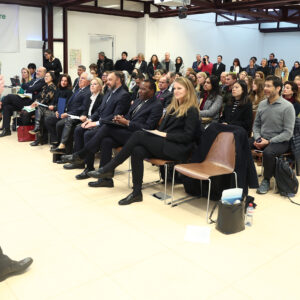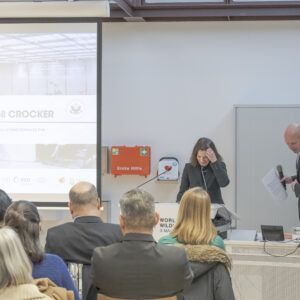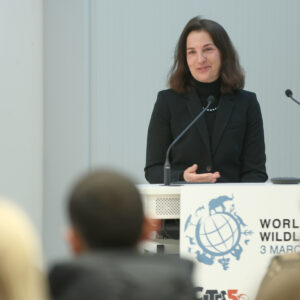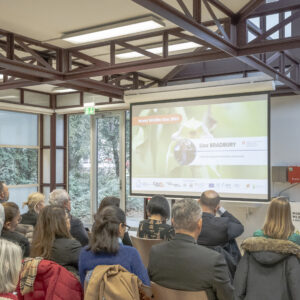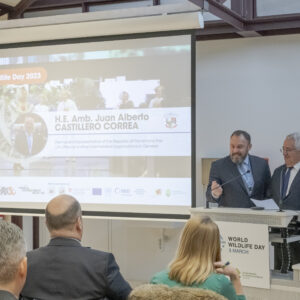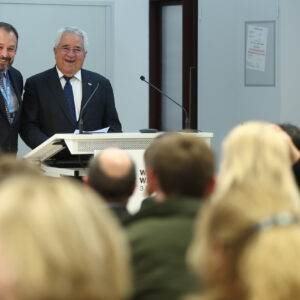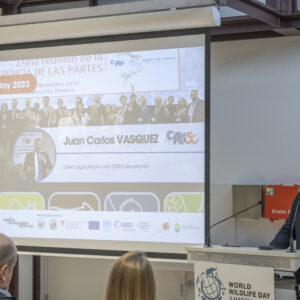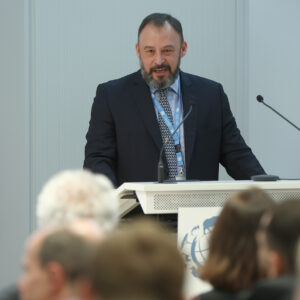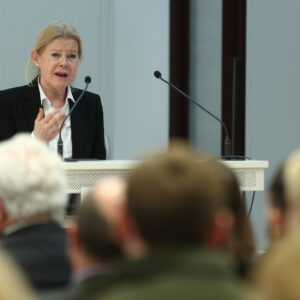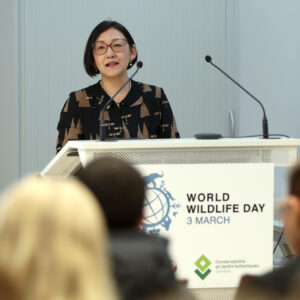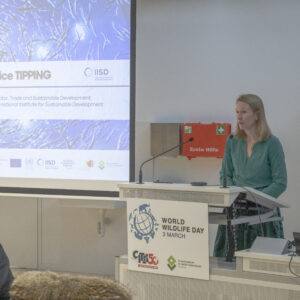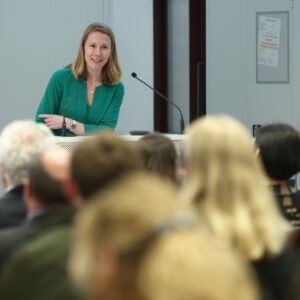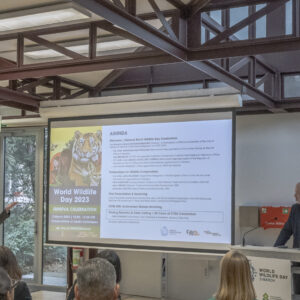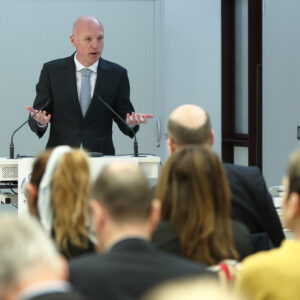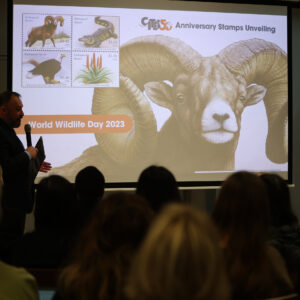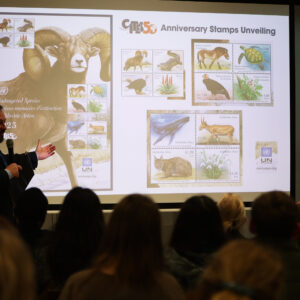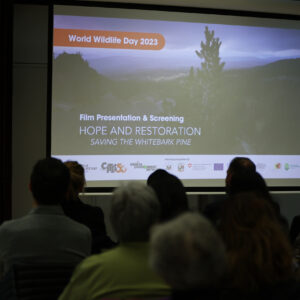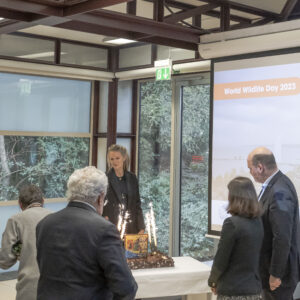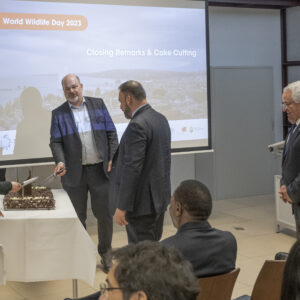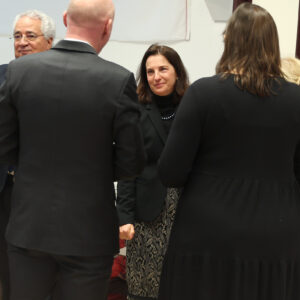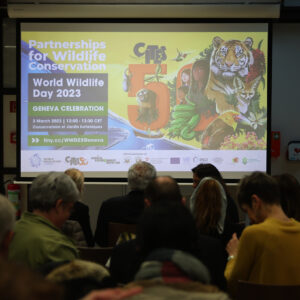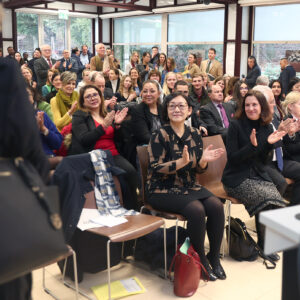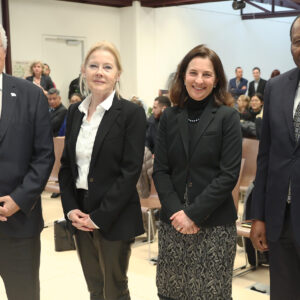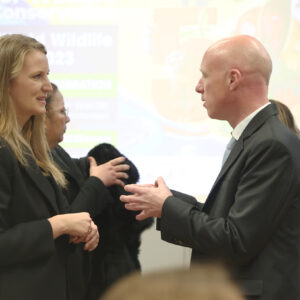Événement Conférence
Geneva World Wildlife Day Celebration | 50 Years of Partnerships for Wildlife Conservation and Sustainability
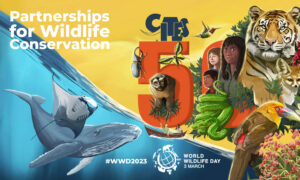
03 Mar 2023
12:00–13:30
Lieu: Conservatory and Botanical Garden
Organisation: Convention sur le commerce international des espèces de faune et de flore sauvages menacées d'extinction, Geneva Environment Network, Suisse
World Wildlife Day takes place on 3 March, a day to celebrate and raise awareness of the world’s wild fauna and flora. Celebrating the 50th anniversary of CITES, this year’s theme is “Partnerships for Wildlife Conservation”, in recognition of the work CITES does and the collaborative work and partnerships for conservation that is going on at the local, national, and global level.
About this Event
On 20 December 2013, at its 68th session, the United Nations General Assembly proclaimed 3 March as World Wildlife Day to celebrate and raise awareness of the world’s wild fauna and flora. This date is also the day of the adoption in Washington of the Convention on International Trade in Endangered Species of Wild Fauna and Flora (CITES) in 1973, which plays an important role in ensuring that international trade does not threaten the species’ survival.
Celebrating the 50th anniversary of CITES, this year’s World Wildlife Day theme is “Partnerships for Wildlife Conservation”, in recognition of the work CITES does and the collaborative work and partnerships for conservation that is going on at the local, national, and global level. This year’s theme presents an opportunity to highlight the people and organizations who are making a difference, as well as to celebrate the bridge CITES has been for these partnerships to form, making a significant contribution to sustainability, wildlife, and biodiversity conservation.
In line with the World Wildlife Day 2023 Global Event taking place in Washington D.C., the CITES Secretariat and the Geneva Environment Network organized a light ceremony and film screening, that highlights wildlife as an important component of biological diversity and how its conservation and sustainable use will help reduce the risk of unprecedented extinctions from overexploitation. The documentary is part of the International World Wildlife Day Film Showcase organized annually by Jackson Wild.
The event ended with a reception, which began with a cake-cutting ceremony that celebrates the 50 years of the signing of the Convention. The celebration was held in the city of Geneva’s Conservatory and Botanical Garden. Occupying roughly 28 hectares, the botanical garden is home to a living collection of more than 15,000 species of wild or cultivated flora, which includes a variety of CITES protected species, and a herbarium of nearly 6 million botanical specimens.
Speakers
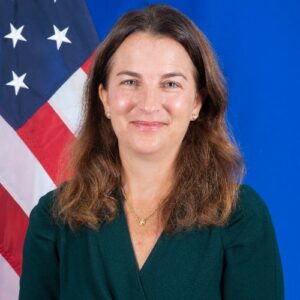
H.E. Amb. Bathsheba Nell CROCKER
Permanent Representative of the United States to the United Nations Office at Geneva
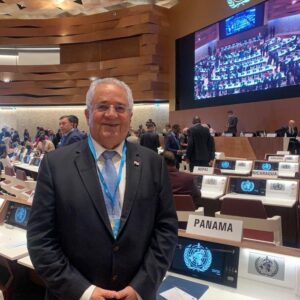
H.E. Amb. Juan Alberto CASTILLERO CORREA
Permanent Representative of the Republic of Panama to the United Nations Office and other international organizations in Geneva
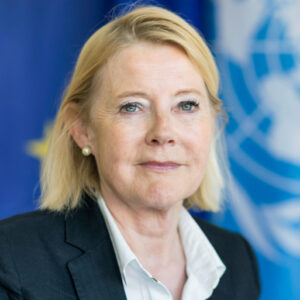
H.E. Amb. Lotte KNUDSEN
Head of the Delegation of the European Union to the United Nations and other international organizations in Geneva
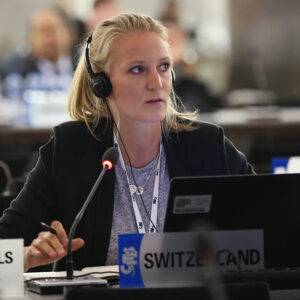
Lisa BRADBURY
CITES Management Authority, Switzerland
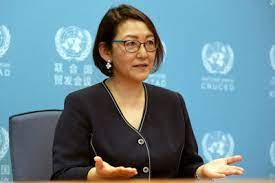
Miho SHIROTORI
Acting Director, Division on International Trade and Commodities, UN Conference on Trade and Development

Alice TIPPING
Director, Trade and Sustainable Development, International Institute for Sustainable Development

Sami KANAAN
Vice-Mayor, City of Geneva & President, Geneva Cities Hub

Nicola SCHOENENBERGER
Director, Conservatory and Botanical Garden of the City of Geneva & Member of the Swiss Delegation to CITES COPs | Moderator
Summary
Welcome | Geneva World Wildlife Day Celebration
Nicola SCHOENENBERGER | Director, Conservatory and Botanical Garden of the City of Geneva & Member of the Swiss Delegation to CITES COPs | Moderator
Today, 50 years ago, on March 3, 1973, the Convention on International Trade in Endangered Species of Wild Fauna and Flora (CITES) was signed in Washington. We are here to honor the 50th birthday of the signing and to celebrate World Wildlife Day. The 3rd of March was chosen by the United Nations to be World Wildlife Day, and this year’s theme “Partnerships for Wildlife Conservation” is an opportunity to highlight the people and organizations who are important partners to CITES Convention, who are making a significant contribution to sustainability, wildlife, and biodiversity conservation. CITES offers varying degrees of protection to almost 39’000 different species, 85% of them being plants.
Let me warmly welcome you here at the Geneva Botanical Garden and take this opportunity to thank the CITES Secretariat and the GEN for organizing the event, and the Swiss Confederation for its support.
The Conservatory and Botanical Garden of the city of Geneva is a 19th-century scientific museum. We have a library with all the botanic works ever published in the world. We have an amazing living plant collection, as well as seed vaults, molecular genetics laboratories, and DNA collections. We are also registered as a scientific institution with CITES, which facilitates the exchange of specimens for research or conservation purposes.
H.E. Amb. Bathsheba Nell CROCKER | Permanent Representative of the United States to the United Nations Office at Geneva
In the past 50 years, CITES has become the signature international agreement for safeguarding world wild plants and animals from exploitation due to international trade. It is the key tool to ensure that the trade of species is legal, regulated, and sustainable. CITES now counts 184 contracting parties and protects nearly 40,000 species against exploitation in trade.
I am proud to speak today not only because of the special connection that the United States shares with CITES, as its first signer, but also because of my own appreciation for wildlife conservation and endangered species. I grew up spending summers between two places. One was in Zimbabwe, where my mother was born, and my grandparents still lived at that time. I spent part of my childhood seeing wildlife across African countries. I also spent other parts of my summers in the Adirondack Mountains in upstate New York, where my grandfather was a key conservationist, something that my father carries on today. CITES having been signed in Washington, and because of my background, CITES was one of the first things that I studied in the form of an international agreement. CITES really formed part of the reason why I decided to engage in international affairs. So, it’s particularly meaningful for me to be here today.
Threats to the species of our planet are even greater today than they were 50 years ago, as exploitative trade, environmental degradation, and habitat loss continue to threaten the world’s biodiversity. All countries must take bolder action to address these challenges.
In the United States, we’ve strengthened our laws and prosecuted the poachers and criminal organizations who trafficked wildlife, while increasing our support of partner governments to build international capacity to stop poaching and illegal timber harvesting. Together with the Government of Norway and others, the United States is also developing the Nature Crime Alliance to aggressively pursue the powerful criminal networks that engage not only in wildlife trafficking, but also in illegal logging, mining, fishing, and land conversion that destroy natural habitats and precious ecosystems. We’ve also launched a new alliance with Canada and the UK last summer to tackle illegal, unreported, and unregulated fishing, to bring greater transparency to seafood supply chains and combat the harmful practices that are contributing to the collapse of critical ocean ecosystems.
On ocean conservation, the United States recently announced the Ocean Conservation Pledge to encourage countries to protect or conserve 30% of their national waters by 2030. Sixteen countries have already joined this pledge that strengthens our shared commitment to protect ocean biodiversity and animal habitats. These alliances and pledges in tandem with the work of CITES and the UNEP are a testament that today’s theme of partnerships for Wildlife Conservation is uniquely fit. International cooperation is the key to countering animal exploitation and biodiversity loss. Let’s use today to celebrate our collective accomplishments of the past 50 years of CITES while renewing our shared commitment to bold collective action to protect and conserve the world’s ecosystems and the creatures that inhabit them.
H.E. Amb. Juan Alberto CASTILLERO CORREA | Permanent Representative of the Republic of Panama to the United Nations Office and other international organizations in Geneva
Currently, the international wildlife trade involves thousands of millions of dollars and hundreds of millions of animals and plants. Export levels are high, and trade, combined with other factors such as habitat destruction, can significantly deplete populations and push some species to the brink of extinction.
Since 1975, CITES has organized 19 conferences to address this fundamental issue of the survival of life on our beloved planet Earth. Last November 22, we held the latest conference in Panama City, where more than 160 government representatives and about 3000 participants met to adopt decisions that will impact the future of 600 species of animals and plants.
The last COP19 in Panama was a success. It was decided to add new species, almost 100 different species of sharks and rays, more than 150 species of trees, 50 species of freshwater turtles, various species of birds, and 160 amphibians, including “crystal frogs”.
In total, more than 500 species will be listed, making this conference an example of cooperation. Of the 52 proposals presented, 46 were adopted. Let’s celebrate this success and be aware of the global responsibility for the survival of wild flora and fauna which is a task for all of us.
It is worth mentioning that at this very moment in Panama, we are celebrating the Our Ocean 2023 Conference with the participation of more than 600 experts and representatives of states who are engaged in a constant struggle and collective activity to keep the oceans clean, to restore the climate, and to regenerate marine life. This is a fight in which we must all participate.
Panama has 93,390 square kilometers of protected marine area, which represents 54% of its marine territory. This makes Panama the second country in the world with such a high percentage, after Palau, thanks to the initiative of our President, Laurentino Cortizo, the Minister of Foreign Affairs, and the Minister of Environment.
Juan Carlos VASQUEZ | Chief, Legal Affairs Unit, CITES Secretariat
I am proud to say I came up with the idea of World Wildlife Day and that I have spent 25 years working in this Convention. After 50 years, CITES continues to bloom and its roots are well planted in the conservation field and the land of international law. The idea behind CITES originated at the 1963 IUCN General Assembly in Nairobi. CITES was signed in 1973, in Washington, by 80 countries and was called the Magna Carta for wildlife.
CITES is that great charter for nature, recognizing that peoples and states are and should be the best protectors of their own wildlife. The quality and beauty of the text of the Convention make CITES unique. It is focused, pragmatic, specific, action-oriented, and realistic. It establishes an international regulatory regime that has stood the test of time.
We believe that CITES is needed more than ever and continues to bloom because wildlife unites people. Wildlife provides peace. 50 years ago, President Nixon said that the common search for a better environment can be one of those activities which serve to unify nations. This shows that Wildlife serves to unify nations and brings together states and peoples.
CITES focuses on implementation. It’s a regulatory, not a declaratory instrument. This means that we are on the ground daily, working on the real world for a better present, acting now. Our mutual trade rules and listings adopted in Panama last November entered into effect last week and are legally binding. CITES is hard law and soft power at the same time. CITES embraces imperfection and always makes decisions. This means that if there is no consensus, parties vote, make decisions, and move forward. If our authorities don’t have all the perfect science and data available, they adapt, go ahead of science, and make decisions. CITES is mature and well-managed. Legal and sustainable wildlife trade generates benefits for local communities, indigenous peoples, and national economies in rich biodiversity countries.
Today we celebrate our partnerships. We celebrate the 183 States and their people parties to this Convention. We celebrate their vision and commitment. Many thanks to the European Union, the only regional economic organization that is a party to this Convention, because you are a fantastic example of lasting financial and technical cooperation. We also thank the Swiss Government for hosting the CITES Secretariat here in Geneva, for the generous financial support, for being the Depositary Government, and for today’s reception. Thank you to the Geneva Environment Network and to the Director of the Botanical Gardens. Thank you to the staff for all their efforts in organizing the reception.
My final words are to my colleague David Morgan, who is leaving after 20 years of dedicated service. We thank you and wish you a smooth transition from being a CITES staff member to an ex-staff member.
Partnerships for Wildlife Conservation
H.E. Amb. Lotte KNUDSEN | Head of the Delegation of the European Union to the United Nations and other international organizations in Geneva
It’s a great pleasure to be here today for the 50th anniversary of CITES and World Wildlife Day. As ambassadors, we can increasingly help create more awareness of the importance of CITES. We all have an obligation and a role to help with the protection of nature and wildlife.
This year’s World Wildlife Day is dedicated to partnerships, and the list of partners here already set a good example of what we can do in Geneva by bringing different parties together. We all know that biodiversity is in great danger, and in no small part due to the damage we ourselves have unwittingly inflicted upon nature and wildlife over the years. Therefore, it’s also part of our task to try to reverse this trend of weakening or extinction of species. This can’t be achieved without strong partnerships.
Partnerships are very much part of the way the EU works. So, we’ll be strong supporters of this axis of your activities and its partnerships in a multifaceted, multilayered way. That’s partnerships between source, transit, and destination countries. That’s partnerships between relevant authorities, civil society, academia, and the private sector. It’s also partnerships between all relevant international organizations to create synergies on how we can work together and use common frameworks such as the One Health approach. Partnerships are also about multi-stakeholders, which is I think part of the modern world, of modern multilateralism.
In the EU we have always been drivers for a multilateral framework and global rules to try to regulate activity as well as fight trafficking and other damaging behaviors. In the context of CITES, we have always been very actively engaged with range States because we are a major transit and destination market for illegally trafficked wildlife. We also play a role in terms of many listings in many countries, and we provide financial, political, and diplomatic support as well as technical assistance. Our delegations across the world are increasingly engaging in the protection of wildlife and nature. Conservation is one of the issues where we’re trying to sensitize our diplomats across the world. This forms part of a modern diplomatic agenda.
We know having global rules and frameworks is not enough as without implementation and enforcement we cannot achieve results, and this is what your work is all about too. So, agreeing on listings is not sufficient. We try also to help countries with the implementation process of active measures required to enforce the rules agreed upon in CITIES, COPs, and biodiversity frameworks. We are a major donor in the area of biodiversity for many partner countries across the world, and it’s increasingly seen as an integrated policy of the EU in the area of the environment as well as climate. One example of that is indeed NaturAfrica, which is a flagship of EU initiatives to support biodiversity conservation in Africa. It supports key landscapes for conservation and development. It helps create jobs and involve the local communities. It makes local communities take ownership of the importance of nature conservation for economic and let’s call it heritage reasons, meaning how to preserve local communities. This is where we need a win-win situation, so all parties see the value of protecting the environment and preserving our ecosystems. We’re also supporting the implementation of CITES by providing funding for programs such as the CITES Tree Species Programme and the Monitoring the Illegal Killing of Elephants (MIKE) Programme as well as for the activities of the International Consortium on Combating Wildlife Crime. These are just some of the examples of where we are involved. Preserving marine species, as agreed at the recent CITES COPs, is also one of the areas where we work. It will require great amounts of strength and cooperation between CITES and international organizations. Particularly in the area of fishery and in working with local communities to ensure that they also benefit and preserve their natural sort of habitation.
On our own side, we have a revised version of our action plan taking into account a better understanding of how to protect wildlife. It has a much stronger focus on working with local communities, on the enforcement angle, as well as the training of, for instance, rangers and experts to work on concerned areas. This was adopted only four months ago and is very useful for our own follow-up work in the EU. Wildlife trafficking is a very worrying phenomenon. There’s a lot of it arriving in the EU. Not to mention the broader social and economic consequences of wildlife trafficking, as well as its ecological impact. We hope that this action plan will bring much more attention to this area of work among our Member States and our partner countries.
We very much support partnerships to combat wildlife trafficking. It’s part of the notion of global partnerships. We will strengthen, because of this action plan, our efforts in all the countries concerned outside the EU. We will try to create better teamwork between Member States, EU enforcement actors, Member States’ national authorities, and key non-EU countries, to have a triangular operation. We also need partnerships to prevent wildlife trafficking and address its root causes at the local, regional, and national levels. We need partnerships to support livelihoods and the sustainable use of wildlife and wildlife products, by encouraging and facilitating the legal and sustainable sourcing of wildlife products. We know that we can’t do this without the active involvement of civil society and the private sector. They will be very important players in the development and implementation of policies.
Finally, it’s very important to keep all the work you are doing on the broader multilateral agenda. These days there’s so much more awareness of the importance of global multilateral challenges that can only be solved through international cooperation, and this is a very good hook for highlighting the need for everybody to work collectively on CITES to create results in order to make a difference. As the slogan says, this is about saving the planet, and you are part of that process.
Miho SHIROTORI | Acting Director, Division on International Trade and Commodities, UN Conference on Trade and Development
For more than two decades, UNCTAD and CITES have struck a partnership that has withstood economic downturns, geopolitical crises, and the crippling impacts of the COVID-19 pandemic, exacerbated by threats of the triple planetary crisis of biodiversity loss, climate change, and pollution. The Secretary-General of UNCTAD, Ms. Grynspan, wants me to inform you that UNCTAD is fully committed to continuing our partnership with CITES. Thus, honoring the memorandum of understanding that we sign in 2010, which aims at enhancing the livelihoods of the poor in remote and marginal areas that harvest and trade in these wildlife species while ensuring their conservation, and to promote opportunities for businesses that comply with science requirements and national legislation.
I will share some examples of how UNCTAD and CITES have worked together. The first is called UNCTAD ASYCUDA eCITESBaseSolution. It is an automated custom procedure that streamlines the flow of legal CITES listed species trade. It’s in the pilot phase in Sri Lanka. It increased annual approval rates through eCites permits by 17% between 2020 and 2021. More recently, it has been fully implemented in Mozambique. The second example is Blue BioTrade Project. It is a joint project with UNCTAD, CITES, and the Eastern Caribbean community, on the treatment of queen conch. Working together, we have come up with a regional work plan, which will be implemented in the next five years. This example looks at the business model of how the local communities could leave out using some wildlife species but in a way that is sustainable, inclusive, and sustained.
The Secretary-General of UNCTAD and all the colleagues in UNCTAD are fully committed to continuing working with CITES, and we are also very much looking forward to working with all partners for a brighter future for wildlife.
Alice TIPPING | Director, Trade and Sustainable Development, International Institute for Sustainable Development
CITES has inspired many to work at the intersection of trade and the environment. The IISD (International Institute for Sustainable Development) is a non-profit think-tank based in Canada. We have a large office in Geneva from which we do a lot of work on investment, energy, and trade policy. Our role is, essentially, to provide governments with impartial support, and technical and scientific evidence, to help them design policies that best support sustainable development. We do that specifically with trade policy because the WMO is based here in Geneva. A major achievement of that organization and the trade policy community is the conclusion, in June last year, of a multilateral agreement on fisheries subsidies. This is a hugely significant achievement. It is only the second multilateral trade agreement achieved since the WTO was established and is the first multilateral trade agreement with an environmental objective. That objective is to avoid the over-exploitation of the world fisheries resources but more broadly to protect marine ecosystems and the livelihoods of the communities that depend on these ecosystems whether it be for food, jobs or income.
Regarding partnerships, IISD was heavily involved in the negotiations. We provided support and encouragement to the governments negotiating these quite difficult rules for many years. We relied consistently in our work on the input from the CITES Secretariat to help governments understand how they could base and how they could build trade policies, subsidy policies rules based on scientific evidence. This is something the CITES Secretariat had years of experience with, but was quite new and challenging for the trade policy community. My heartfelt thanks to the CITES Secretariat for consistently making staff available to come to our seminars and explain to governments how their system works.
Of course, the work continues. I was in Panama just last week, at a regional Workshop designed to help the governments of Latin America to understand the agreement and to prepare to implement and ratify it. There are ongoing negotiations on additional rules on further damaging subsidies. Of course, we rely on the political diplomatic support of some of the world’s largest economies, the United States and the EU, in pushing those negotiations forwards. We will continue to support governments to ratify and add to those rules and we look forward to calling again on the CITES Secretariat for their experience as our very successful partnership continues.
Film Presentation & Screening
A portion of the film, “Hope and Restoration – Saving the Whitebark Pine“, was screened during the event. It highlights wildlife as an important component of biological diversity and how its conservation and sustainable use will help reduce the risk of unprecedented extinctions from overexploitation. The documentary is part of the International World Wildlife Day Film Showcase organized annually by Jackson Wild.
CITES 50th Anniversary Stamps unveiling
Juan Carlos Vasquez unveils the yearly stamps produced by the UN Postal Administration, which features 12 Endangered Species on stamps. To mark the 50th anniversary of CITES, the UNPA is featuring species of flora and fauna which are conservation success stories.
Closing / 50 Years of CITES Celebration
Sami KANAAN | Vice-Mayor, City of Geneva & President, Geneva Cities Hub
I am very honored to address you. Partnerships are the theme of that celebration. More than ever, we need very close and intense partnerships between all stakeholders to tackle these crucial challenges. The film was a good example of people engaged professionally but also in civil society to preserve our nature biodiversity to the dangers that we face in all places of the world, even in a place like Switzerland supposedly quite protected.
This is a celebration, but celebrations are also an opportunity both to look back on the work that has been done and to recall all the work that remains to be done together. The alarm was given more than 50 years ago, and the Convention itself is the result of many years of work. It has been very useful and important for the conservation of fauna and flora, as well as to contribute to the awareness of the importance of fighting against illegal trafficking and beyond that, preserving our nature. We are very honored to be able to mark this event in Geneva. Geneva today is a city of multilateralism. It is therefore the responsibility of the authorities of the City and Canton of Geneva, as well as of the Swiss Confederation, to ensure that the best possible conditions are maintained so that multilateral activities can take place in Geneva in an inclusive and innovative way, involving all actors who can contribute to the diagnosis, analysis, and to the search for viable solutions that are implemented afterward.
We have a strong scientific tradition, and the Conservatory and Botanical Gardens is greatly appreciated by the population and help raise awareness on the importance of biodiversity. Geneva is a city of science and international diplomacy. Even at the local level, we are very concerned about the loss of biodiversity. For example, we talk about the drought that we have even in Switzerland, which is paradoxical for the water tower of Europe. Like many cities, we have a climate strategy, and we also have a specific strategy for my department, which deals with culture, science, and digital.
As far as cities are concerned, they do not generally make laws, they are at the end of the institutional chain, but they are in the front row of everyday realities in the urban world. Today, more than 50% of the world’s population lives in cities. Cities, therefore, concentrate challenges, problems, but also solutions, because they must find solutions for the population. Cities are therefore working more and more together. We have very active networks of exchange of practices, diagnoses, and solutions, but we are also more and more in contact with the multilateral world.
The Geneva Cities Hub is a platform that was created with the support of the Confederation to connect the multilateral world of Geneva with the world of cities and city networks to ensure mutual benefit. There is a strong demand for interaction with local governments on issues such as health, migration, biodiversity, human rights, etc. Local governments are very interested. At the local level, we try to make sure that this does not remain a debate between specialists. It is vital that the population be associated with the debate and understands these issues. Many activities aim at reaching this objective, and the population is very interested. We are trying to find out with other local governments how to involve the population.
I would also like to pay tribute to the actors of civil society who fight daily for the protection of nature, the scientists, and the Conservatory and Botanical Garden in particular. A big thank you and happy birthday to CITES.
Videos
Livestream on YouTube
Live from Facebook
Juan Carlos Vasquez interview on the 50th anniversary of CITES.
Photos Gallery
Documents
- Presentations made during the event
- CITES 50th anniversary UN Stamps
- Opening Remarks by Ambassador Bathsheba Crocker at World Wildlife Day 2023 Celebration
- Invitation
Links
- Official website of UN World Wildlife Day
- Celebrating World Wildlife Day in Geneva and Beyond
- CITES Website
- UN World Wildlife Day 2023 – Washington D.C. Celebration | 16:00 – 18:00 CET
- Origins and Evolution of World Wildlife Day: Global Celebration of Wildlife | John Scanlon | IISD | 1 March 2023
This article is the final in a series of seven articles on CITES at 50 published by the IISD, the other six being; on compliance, with Professor Christina Voigt; African elephants, with Jonathan Barzdo and Greta Flori; enforcement, with Robert Zoellick; voting and reservations, with Jinfeng Zhou; wildlife-related pandemics, with Dan Ashe and Sharon Deem; and shark listings, with Daniel Kachelriess.

